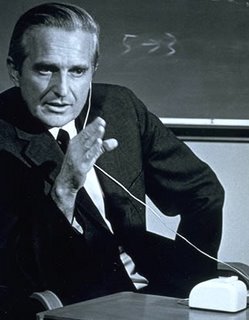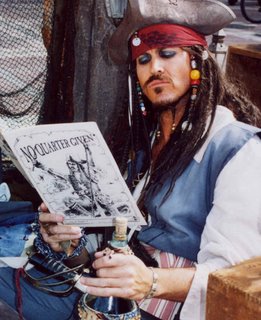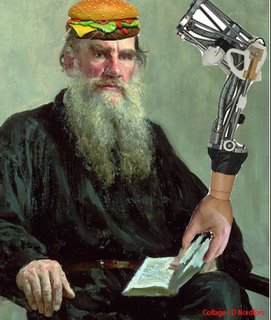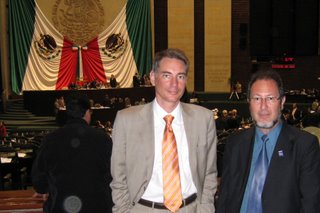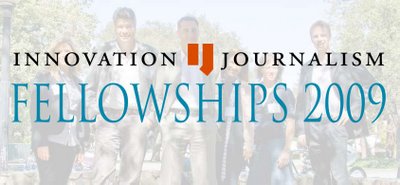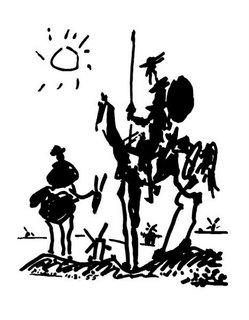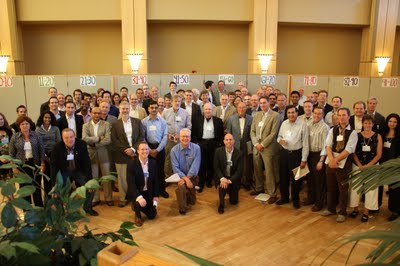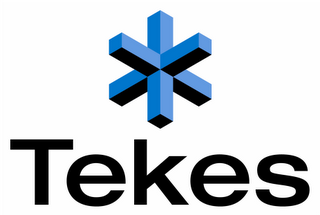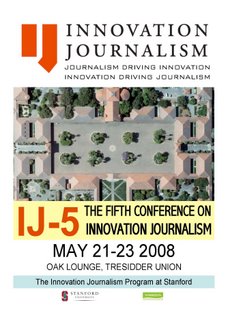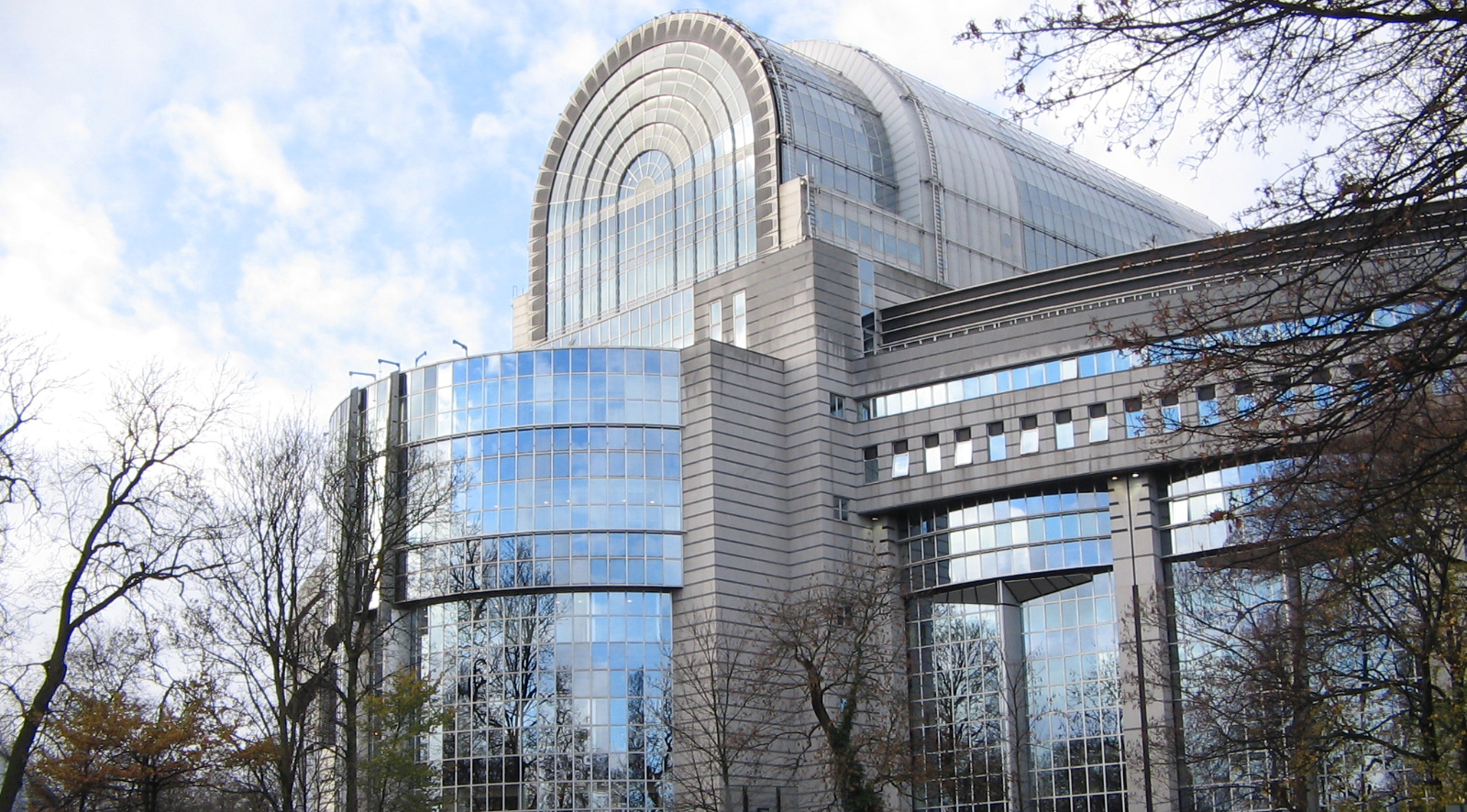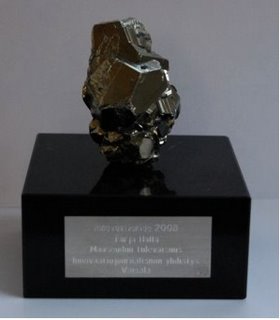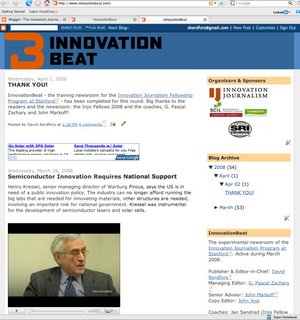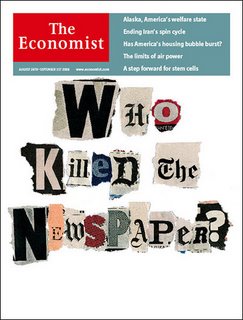 (This story is also being published by the EJC Magazine)
(This story is also being published by the EJC Magazine)This story has been translated into Spanish by Patrcio Cevallos Quito on his Pizarrablog (here)
I have stopped calling journalism "the media", and saying the "media industry" when talking about the companies that make journalism and news. Instead I say "the news industry" or "the journalism industry."
Everybody knows by now that the media industry (I say it intentionally this time) is facing challenges. It is working hard to come to grips with the Internet.
Information theory enabled us to define information without referring to the carrier. Information technology liberates the Karma from the flesh. Information can be ripped off one medium and copied onto another. It can be processed: filtered, distorted, enhanced, synthesized. It can be sorted, compared, matched and aggregated. It can be distributed around the neighborhood or sent into space. The various layers of information and machinery formerly glued together are sliding apart. The same is going for the industries that have been handling them. We are witnessing the progression of the information technology revolution.

In the 1980s software separated from hardware. Software became an industry of its own.
In the 1990s network services separated from the physical networks. Network services became an industry of its own.
Now, the content - the narratives - is separating from the media. What we know as the Media Industry is on its way to separating into two industries: those that provide the medium and those that provide the narratives. The trend is a shift away from vertical integration, where single companies own the whole chain from the journalists to the printing presses and the trucks. Perhaps vertical integration can come back someday in another shape, Steve Jobs is showing it's possible for personal computers.
But right now, the trend in what has become known as the media industry is to separate. It used to be a good business for newspapers to own a printing press and trucks. Now it is becoming a liability. Using fossil fuel to deliver yesterday's news printed on dead trees is not a sustainable prospect. With the Internet it is a different game. It is definitely not about owning hardware, and it is not a good idea for news organizations to be Internet Service Providers. It is probably not even a good idea to own the software platform that works as medium for the news stories. Filling the basement below the newsroom with software engineers is expensive, it is much cheaper to use open available platforms, like Blogger, YouTube or Facebook. They are probably ore reliable anyway. And if New York Times will build their own platform, the other news outlets will not want to use it, so teh Times will need to take all the development cost themselves. Bad business.
Media companies are becoming confused. What is their core identity? Editorial content? Marketplaces? Blogospheres? Social networks? The traditional unified bundle of medium, content and classifieds is falling apart; the media industry no longer knows what it is.
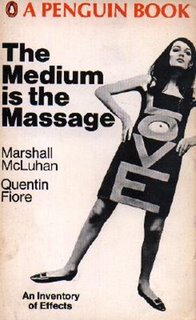
It is not that Marshall McLuhan's "The Medium is the Message" isn't valid for the bigger picture. The message is now "Internet." That message is so big
So what happens to journalism? It will survive, but the circumstances will change. Journalism will not be run by people who control media. Not as things look now. Maybe some new medium that can do it will emerge some day.
But the essence of journalism was never really about mass communication technology, anyway. The deeper concept has always been collective attention. The big business model of mass media has always been generating and brokering attention, what I call "attention work." When newspapers and broadcasters sell ads, they are actually selling the attention of the audience, which was generated by their journalists. The traditional mass media attention business model is A) control a carrier of information that can reach the masses, B) generate attention around the carrier by transmitting interesting information on it and C) sell the attention by charging advertisers for broadcasting their information over your carrier.

How to contain and sell the attention? Controlling the carrier has so far been the answer. This used to mean owning a printing press and the trucks for delivering newspapers, or owning a radio or a TV channel. Not everybody could do that. It required organizations and capital. On the Internet, anybody can publish. It does not require any organizations or capital. Even worse, on the Web, audience attention jumps around wildly. So even if you manage to get a lot of attention, it is not easy to collect it and transfer it to someone else. People will read your story, click on some link that leads to someone else's page, and click on an ad there. Or they will find your story through Google, and click on ads there. The Internet does not encourage walled gardens. Today it is all about revolving doors. The attention workers on the 'Net nowadays refer to audience as "traffic".
In principle, journalism should be in better shape than ever. The core competence of journalists is to generate attention. If you think that sounds bleak, think again - it is very rich. Everybody wants to inform society, only those who can generate attention succeed.
Attention is becoming an increasingly scarce commodity in a world where the problem is not a lack of information, rather the abundance of it. The competition for peoples' attention is fierce. It was easier to manage attention in the walled garden than it is among the revolving doors. We live in an attention economy, and it is going global.
When the attention economy grows, the market grows for attention workers, who generate and broker attention professionally. Do not mix them up with knowledge workers, who generate and broker knowledge professionally. Engineers and analysts are knowledge workers. An advertiser is an attention worker. Journalists are mostly attention workers (they are knowledge workers if they are paid by the audience, and not by advertisers). When journalists switch professions they often go into PR and communications. Attention workers can jump between different attention jobs. Attention workers and knowledge workers have different cultures. The difference is in "need to know" vs. "want to know". Read more about it here.
Public attention is a requirement for public debate. Society needs it. Without shared attention it will be difficult generating shared language that lets people collectively identify which issues are important. Language enables them to act. With everybody trying to catch everybody else's attention, competition for public attention has become even more interesting.
At the same time, attention is gravitational. Attention attracts attention. Everyone is interested in knowing what everybody else is talking about. This is the explanation behind a lot of celebrities and fads. A number of celebrities are famous for being famous. People follow fads because they know other people are following fads.
Reasonably, there is now greater value than ever in generating and brokering attention. The competition is greater. There are more voices. But this does not mean that the era of champions is gone and the grassroots movements will rule the fore. Quite the opposite.
The Internet is creating a global, interconnected, real-time market. Soon, nearly everybody will be online. If a superstar gets the attention from half of the world of any community, will the other half be able to avoid giving their attention, too? They will give at least half an ear. With all the overlapping communities, adding up to the world community, there will be an ecosystem enabling protagonists to play for omni-global attention. The Internet can become the nervous system of a global collective consciousness (although a number of regional powers will try to stop this from happening).
In short, Internet is the biggest opportunity so far for professional journalism. It is true that now that everybody can publish, everybody can be a journalist. But it is not true that everybody will be a journalist.

I was in the first punk rock wave that reached Sweden in second half of the 1970s. Punk rock told us that we could do better than watch Led Zeppelin play, fighting among thousands of other fans to get a peep of them on the stage far away. We now could go to the local club and watch our friends play raw rock music. Even better - anyone who wanted to play could start a band. There was no natural competition between bands. There was a lot of collaboration. Mass-produced instruments where cheap. Nobody cared much if you did not play on a Gibson Les Paul or Fender Stratocaster guitar. I recall a guitarist bragging about playing a "Gippson" guitar. Cheap was cool. Recognize it today?
Blogs are punk rock. It's the Blogosphere vs the Main Stream Media. I recognize it all from the punk rock days.
But in 1976, some teenagers in Dublin started a garage band named "U2." In 1981, Rolling Stone Magazine called them the next big thing. They became superstars. Just like Led Zeppelin.
Who will become the U2 of journalism blogs? It is bound to happen. There are a number of candidates by now: TechCrunch, VentureBeat, GigaOm, Engadget, Huffington Post. They have all gone past being garage bands playing for free at local pubs. They are running commercial operations employing people and working on finding new business models.
Some of these blogs are growing larger audiences than many so-called "mainstream media". Their style is maturing. They are renewing journalism.
Everybody can blog. Not everybody can be a journalist. Who is a journalist on the Web?
Journalism is about serving an audience. There has been a lot of work done on the principles of journalism. These principles are perhaps best codified at Journalism.org. They include some tricky concepts like "truth" and "objectivity," which are very difficult to nail down. But the general message is there: It ain't journalism if it doesn't serve the interest of the reader. I subscribe to that.
So how do we know if a blogger is serving the audience or him/herself?

Swedish botanist Carl Linnaeus showed it was a good idea to categorize plants by the visible characteristics of their reproduction mechanisms. Generally, a concept needs to have a reproduction mechanism to hang around. In any profession or business, that mechanism involves a business model. Without a business model that reinforces journalism, journalism will cease to exist as a profession. Let's look at the basic principles of the journalism business model.
There are today three business principles for journalism: one that sells content to the audience (e.g., newsletters), one that sells the attention of the audience (e.g., ad-based publications), and one that gets sponsorship for delivering information to the audience without biasing the message in favor of the sponsors (e.g., public service).
All three business models depend on one thing: loyal attention from the audience. In order to draw loyal attention from the audience, the journalist has to in return be loyal to the audience. This is the difference between journalism and PR. Public relations works on behalf of the source. Journalism works on behalf of the audience. If journalism loses the attention of the audience, it will not have customers. It will not have advertisers. It will not have sponsors.
For amateur bloggers, this does not matter much. They will publish what they want, not having to show loyalty to anyone.
But if they start getting a lot of attention, they will have to choose if they want to benefit from it. If they choose to build a reputation on the attention they are receiving, they will soon become dependent on it. The more their reputation depends on the loyal attention of the audience, the more they will need to care about their loyalty to their audience. This is true for both rock bands and bloggers. Original punk rockers would not suck up to anyone, including an audience. For U2, the audience is their constituency.
Until now, a journalist has been defined as someone working on behalf of an organization with a journalism business model. All such organizations have had business models that manage printing newspapers or broadcasting, something that has required considerable effort and varying amounts of cash flow.
The Oxford Dictionary on the Internet - askoxford.com - defines journalism as "the activity or profession of being a journalist", and defines a journalist as "a person who writes for newspapers or magazines or prepares news or features to be broadcast on radio or television."
That has until now been a convenient definition. Either you are a journalist or you are not. The requirement is being connected to an organization that controls a medium.
With the Internet, that no longer applies. Anybody can publish on the Internet. But there will be a power distribution of attention (the same type of curve as the famous "long tail"). Some people will get a lot of attention. Others will get attention only from family and close personal friends. Journalism will be done by sites producing news that have developed a dependence on their audience, forcing them to be loyal to it.
Therefore, at the core of maintaining journalists is the loyalty to the audience and a business model that reinforces the loyalty to the audience. If that is in place, journalism will flourish as a profession in the attention economy.
Storytelling, attention and loyalty between journalism and audience, and a business model that keeps reinforcing it. This should do the trick for defining journalism in modern times.
So let's look at how journalism is defined today, in December, 2008. It shows the state of consciousness around these issues.
Contemporary Definitions of Journalism
Encyclopaedia Britannica at www.britannica.com follows the Oxford dictionary; journalism is "reporting news for media: the profession of gathering, editing, and publishing news reports and related articles for newspapers, magazines, television, or radio."

It is ironic the Internet is not mentioned in the askoxford.com and Britannica.com definitions of journalism. A recent OECD report suggests it is high time they do something about it. By 2007, 58 percent of OECD country households had access to the Internet. Korea was in the lead, with 94 percent. Non-OECD economies are following, with some, like Singapore and Israel, well ahead of OECD averages. Eighteen percent of all OECD Internet users created Web pages in 2007.
The effects on media industry will just grow. Japan had as many as 35 million people reading blogs in March, 2007, double the number two years earlier. Internet advertising accounted for 7 percent of global advertising expenditure, growing faster than on any other medium. This is a very important indicator, since the traditional business model for journalism earns money by selling ads.
It can be that Oxford and Britannica are experiencing a dilemma: Saying "Joe is an important guy, he was on TV" convinces people Joe is important, even if the ring of importance has ebbed since there came more cable channels than people could count. Saying "Joe is an important guy, he was on YouTube" is not at all convincing. But when Barack Obama broadcast his talks on YouTube, it was seen as very important. Lesson: It is not about the medium, it is about symbols of collective attention and reputation. As the medium becomes shared by increasing number of very diverse brands, the medium will mean less, and the brands will need to mean more.
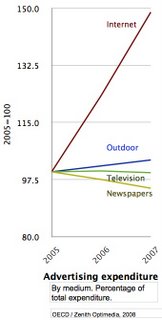
It seems the Internet and YouTube are confusing concepts for people trying to define journalism in terms of media. Why?
Traditional media, like newspapers, TV and radio, are all one-to-many communication infrastructures. The infrastructures are operated by publishers/broadcasters. Therefore the infrastructure comes to represent the publishers/broadcasters in peoples' minds.
The traditional media are built around certain hard technologies, printing presses or radio transmitters and receivers. This limits the information they deliver. Newspapers can't deliver real-time information, video or sound. Radio and TV are very linear - they deliver only one moment at a time on each channel, limiting the overview. This makes people connect the different media to different types of storytelling: Newspapers are good for analysis, depth and length. TV is good for visualization, emotions and breaking news.
The Internet is not a traditional medium. The Internet does not lock in the information. The core of the Internet, TCP/IP, is not much more than a protocol for sending information across connected digital networks that speak different languages and use different technologies. If anything, it loosens the bonds between the content and the carrier. The vision is that any machine can be connected, any content carried. It does not matter if the content is text, sound or pictures. It does not matter if the information is old or new. There are no special types of contents or emotions that become the character of the Internet. Everything is about packages of bits. The communication does not need to be one-to-many. It can be one-to-one, many-to-one, one-to-many or many-to-many. There is no obvious connection between it and publishers/broadcasters. The medium is no longer controlled by "the media".
Wikipedia's definition is slightly less problematic in this sense: "Journalism is the profession of writing or communicating, formally employed by publications and broadcasters, for the benefit of a particular community of people. "
The hard technologies of mass communication are moved backstage; no listing of "newspapers, radio and TV". The Internet can fit into it, leaving Wikipedia one up on Oxford and Britannica.
But Wikipedia runs instead into another problem. Wikipedia defines journalism as a profession, working for the benefit of the audience. The benefit of the audience is OK. It is in line with the second principle of journalism of the Committee of Concerned Journalists: "its first loyalty is to the citizens." Real life may often be more cynical than that, but clearly loyalty is a requirement journalism.
When Wikipedia liberates the definition of journalism from the delivery infrastructure, like newspapers or TV, it lets go of a strong argument: journalism is a profession. Perhaps Wikipedia is compensating by stating journalists must be formally employed by publications or broadcasters. This definition saves journalism as a job, but it weakens the definition as such.
Is journalism always a profession? Dan Gillmor has for some years argued that journalism is becoming an act instead of a profession. Dan makes the case for citizen journalism, where the the audience will be journalists. While the greater involvement of the audience in journalism is beyond doubt, the breakthrough of true citizen journalism is waiting to happen. Regardless the outcome, Dan is making a strong point against the traditional journalism profession. People now better think twice before using 'profession' as a component in the definition of journalism.
In each case, Wikipedia gets it plain wrong in defining journalists as "formally employed by publications and broadcasters." What about freelancers?
The Oxford, Britannica and Wikipedia definitions of journalism all rely on a crutch, relating to
Wikipedia catches a part of the essence in "communicating for the benefit of a community." But that is not enough for defining journalism. Teachers, lobbyists and PR people can all be communicating for the benefit of a community, but they are not journalists. Wikipedia sorts them out by adding "employed by a publication or broadcaster." That sounds like a circular definition, it's like saying "journalism is when journalists communicate for the benefit of a community."
A good definition of journalism enables it as a profession without defining it as one. I also think it is possible to make a definition of journalism that does not bundle it with the medium that carries it. A good definition defines journalism by its essence, and not by its circumstances.
Finally, let's look at the American standard reference. Merriam-Webster Online plays it safe with many definitions.
Journalism is defined as 1 a: the collection and editing of news for presentation through the media b: the public press c: an academic study concerned with the collection and editing of news or the management of a news medium 2 a: writing designed for publication in a newspaper or magazine b: writing characterized by a direct presentation of facts or description of events without an attempt at interpretation c: writing designed to appeal to current popular taste or public interest
News is defined as 1 a: a report of recent events b: previously unknown information news for you c: something having a specified influence or effect news for lawns and gardens — Garrison Keillor> news>2 a: material reported in a newspaper or news periodical or on a newscast b: matter that is newsworthy3: newscast (a radio or television broadcast of news)
Websters is actually doing reasonably well, they just need some weeding. Journalism 2b and, especially, 2c will continue to work in the future, as may 1c. The definition of news is also doing well in cases 1a, 1b and 2b.
But the rest may not serve their purpose in due time.
========================
***Addendum March 13 2011****
After writing this post, I did come up with a suggested definition for "Journalism":
"Journalism is the production of news stories, bringing public attention to issues of public interest. Journalism gets its mandate from the audience. It is required to act in the interest of its audience."
("Innovation Journalism, Attention Work and the Innovation Economy", D. Nordfors, Innovation Journalism Vol.6 No.1. / 2009)
I got some critique on that by Carl-Gustav Linden, who said that "public interest" weakens the definition. There is journalism that is not in the interest of the public. I bought that and revised the definition:
"Journalism is the production of news stories, bringing public attention to issues that interest the public. Journalism gets its mandate from the audience. It is required to act in the interest of its audience."

